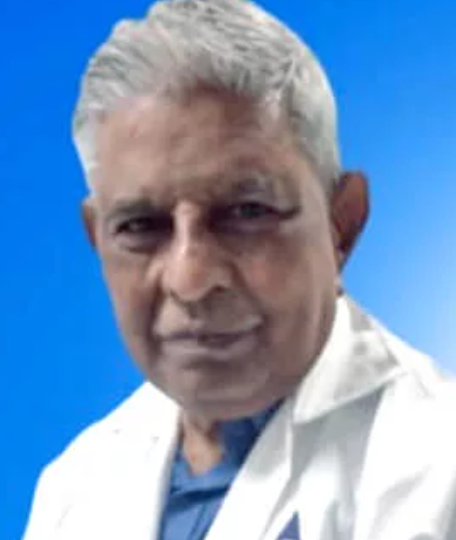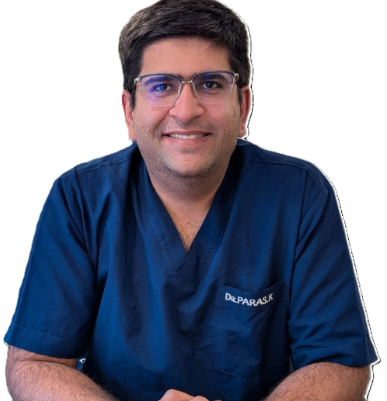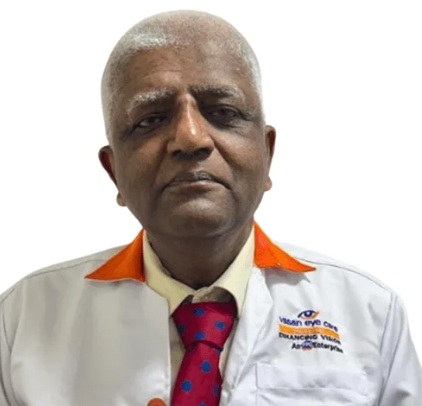Cataract Treatment without Surgery in India

Quick Summary
- Cataracts are a common eye condition that affects millions of people around the world
- The condition is characterized by a clouding of the natural lens of the eye, which can lead to reduced vision, glare, and difficulty seeing in low light
- For decades, the only treatment option for cataracts has been surgery
- However, in recent years, there have been new developments that offer a cataract treatment without surgery alternative to traditional surgery
Table of Contents
Cataracts are a common eye condition that affects millions of people around the world, including India. The condition is characterized by a clouding of the natural lens of the eye, which can lead to reduced vision, glare, and difficulty seeing in low light.
For decades, the only treatment option for cataracts has been surgery, which involves removing the cloudy lens and replacing it with an artificial one. However, in recent years, there have been new developments that offer a cataract treatment without surgery alternative to traditional surgery.
This article will discuss the various cataract treatment without surgery which are available in India and how they can benefit patients. But let us first discuss the causes and stages of cataract.
Causes of Cataract
The following factors can contribute to cataract formation:
- Aging: Cataracts are most commonly found in older individuals, and the risk of developing cataract increases with age.
- Exposure to UV radiation: Long-term exposure to UV radiation from the sun or other sources can increase the risk of developing cataract.
- Diabetes: Individuals with diabetes are more prone to developing cataract.
- Smoking: Smoking tobacco can increase the risk of developing cataract.
- Medications: Certain medications, such as corticosteroids, can increase the risk of developing cataract.
- Previous eye injury or surgery: Previous eye injuries or surgery can increase the risk of developing cataract.
- Heredity: Some people may be more likely to develop cataract due to a family history of the condition.
It's worth mentioning that possessing one or more risk factors does not necessarily mean an individual will develop a cataract.


Stages of Cataract
Cataract can also be classified based on their stage of development. Your eye doctor can determine the type and stage of your cataract and recommend the appropriate treatment. Cataract is typically classified into four stages:
- Stage 1: During this phase, the cataract is in its infancy and may not have any discernible impact on vision.
- Stage 2: In this stage, it has developed enough to cause slight changes in vision, such as difficulty reading or seeing at night.
- Stage 3: The cataract has progressed enough to cause significant changes in vision, such as difficulty seeing colours or distinguishing objects.
- Stage 4: Fully developed in this stage, causing severe vision loss.
Stages of cataract development can vary from person to person and may progress at different rates. Your eye doctor determines the stage of your cataract and decides whether you need new cataract treatment without surgery or with surgery.
Cataract Treatment Without Surgery in India
Treatment for cataract, usually entails surgery to extract the clouded lens and replace it with a synthetic one. However, there are other several non-surgical treatment options for cataract that may be used in some instances. These include:
- Non-surgical methods
- Ayurveda
- Homeopathy
- Yoga
Non-Surgical Treatment for Cataract
Non-surgical treatments for cataract may be effective in certain cases, but may not be suitable for all patients. Cataract treatment without surgery includes:
Conservative Management
Conservative management is one of the best approaches for cataract cure without surgery. This approach involves using glasses or contact lenses to help improve vision. Below mentioned are some key points to understand about conservative management for cataract:
- It improves vision: By using glasses or contact lenses; patients can see better, reducing the blurriness and glare caused by cataract.
- It is not recommended for everyone: This approach is usually only recommended for people who have cataract that is not affecting their vision severely or is not good candidates for surgery.
- It can delay the need for surgery: By using conservative management to improve vision, patients may be able to delay surgery to remove the cloudy lens.
- It should be used under the guidance of a healthcare professional: Conservative management should only be used under the direction of an ophthalmologist or other eye care professional to ensure that it is the appropriate approach for a particular patient.
- It's not the only alternative: It's essential to understand that non-surgical treatments for cataract are not considered the first line of treatment, and it's best to consult a medical professional to determine the best course of action.
Note: Conservative management is not a permanent treatment. It does not remove the cloudy lens but only alleviates the symptoms.
Cortex Removal
Cortex removal is another approach for cataract removal without surgery. The method involves using ultrasound energy to remove the cloudy outer layer of the lens, called the cortex, while leaving the nucleus, or central part of the lens, in place. The surgery is generally done as a daycare procedure, lasting about 15 to 20 minutes.
This procedure is performed as follows:
- During the procedure, the eye is numbed with a local anaesthetic, and an ultrasound probe creates a small opening in the front of the lens.
- The probe is then used to deliver ultrasound energy to break up and remove the cloudy outer layer of the lens, called the cortex.
- Cortex removal can be beneficial for certain cataract patients because
- It can improve vision by removing the cloudy layer from the lens, making it more transparent.
- Additionally, it can be a good option for patients who are not the right candidates for surgery or who have medical conditions that would make surgery too risky.
- It is important to note that this technique is also not considered the first line of treatment, and surgery is still the most effective treatment for cataract in most cases. Patients should consult an ophthalmologist to decide if this option suits them based on their case.
Ayurvedic Methods for Cataract Treatment
Ayurveda is a historical system of medicine that had its origin in India. It is one of the safest approaches for cataract treatment without surgery in India. Cataract can be treated using several methods in Ayurveda. Some of the Ayurvedic techniques used to treat cataract are listed below.
Nasya
Nasya is a technique in Ayurveda that involves instilling medicated oils into the nostrils. This can be done using a dropper or a nasal spray. The idea behind Nasya is that the nose is the doorway to the head and the brain. Lubricating and detoxifying this area can help to improve the overall health of the head and the eyes.
The medicated oils used in Nasya can vary depending on the treated condition and the individual's body type and constitution. Commonly used oils for cataract treatment include sesame oil, ghee, and liquorice oil.
Procedure:
- The Ayurvedic practitioner usually asks the patient to lie down on their back and tilt their head.
- A few drops of oil are then instilled into each nostril.
- It is advised to keep the head leaned back for several minutes to allow the oil to be absorbed into the nasal passages.
Netra Tarpana
Netra Tarpana is an Ayurvedic treatment that involves making a small well or "tarpana" around the eyes which are then filled with a mixture of ghee (clarified butter) and other herbal ingredients. This treatment is said to nourish and lubricate the eyes and improve vision.
Procedure:
- The procedure for Netra Tarpana typically lasts for 20 to 30 minutes and involves the following steps:
- The person receiving the treatment lies down on their back, with the head supported and the eyes closed.
- A dough ring (made from whole wheat flour and water) is then made around the eyes.
- The Ayurvedic practitioner then makes a warm mixture of the ghee and herbal ingredients, such as liquorice powder and amla powder.
- The warm, medicated ghee is poured into the well created around the eyes. The person receiving the treatment is asked to open and close their eyes several times to allow the ghee to circulate in the eyes.
- After the treatment, the person is advised to rest for a short period and to avoid eating or drinking for a little while.
Anjana
Anjana is an Ayurvedic treatment in which a herbal paste is applied to the eyes. The objective of this therapy is to purify the eyes and enhance vision. Anjana includes common herbs such as Liquorice, Triphala, Amla and Haritaki. Anjana is considered to be the safest cataract treatment without surgery.
Procedure:
The procedure for Anjana typically involves the following steps:
- The person receiving the treatment is made to lie down on their back, with the head supported and the eyes closed.
- The practitioner prepares a paste by mixing the herbal powders (liquorice, triphala, amla and haritaki) with ghee or honey.
- This paste is applied gently to the closed eyelids and the areas around the eyes.
- The person receiving the treatment is asked to keep their eyes closed for about 15 to 20 minutes.
- After the treatment, the person is asked to wipe the paste off gently with a clean cloth or cotton and advised to rest for a short period.
Dhara
Dhara involves pouring a stream of warm medicated oil or buttermilk over the forehead. This treatment is said to help soothe the eyes and improve vision.
Procedure:
- The process of treatment of Dhara is similar to other Ayurvedic treatments, which is one of the best cataract treatment without surgery which usually takes about 30 to 40 minutes to complete. It involves the following steps:
- The person receiving the treatment is made to sit comfortably, with the head tilted back and a small shallow dish placed on the forehead.
- The Ayurvedic practitioner prepares a warm medicated oil or buttermilk by mixing it with herbal ingredients such as liquorice, amla, and ghee.
- The practitioner then pours the warm medicated oil or buttermilk over the forehead, allowing it to flow into the shallow dish placed on the forehead.
- After the treatment, the person is instructed to gently wipe off the oil or buttermilk with a clean cloth or cotton. They should rest for a short period and avoid eating or drinking.
Pinda Sweda
Pinda Sweda is an Ayurvedic treatment that involves applying warm boluses (small bags filled with herbal powders, herbs and medicated oils) to the head and eye region. The goal of this treatment is to improve circulation to the eyes and improve vision. Pinda Sweda is one of the best approaches for cataract treatment without surgery.
Procedure:
Pinda Sweda generally involves the following steps:
- The person receiving the treatment lies down on their back, with the head supported and the eyes closed.
- The practitioner prepares boluses by filling cotton bags with herbal powders, herbs, and medicated oils.
- The boluses are heated in a medicated decoction or medicated oils.
- The warm boluses are applied to the head and eye region, covering the eyes as well, and kept in place for about 15 to 20 minutes.
- After the treatment, the boluses are removed, and the person is advised to rest for a short period.
Note: Pinda Sweda should only be done under the guidance of an experienced Ayurvedic practitioner, as an improper technique or use of the wrong herbal ingredients can cause irritation or other side effects.
Homeopathic Methods to Treat Cataract
Homoeopathy is a holistic system of medicine that uses highly diluted natural substances to treat a wide range of health conditions. It is one of the safest cataract treatment without surgery. Some of the homeopathic methods that are used to treat cataracts include:
- Apis Mellifica: This remedy is made from the venom of the honeybee and is often used to treat cataracts accompanied by red, swollen eyes and sensitivity to light.
- Calcarea Carbonica: This remedy is made from oyster shells and is used to treat cataracts associated with a lens's hardening. It is also used to treat individuals who may have a tendency towards cataract.
- Phosphorus: This remedy is made from a chemical element and is used to treat cataracts accompanied by night blindness and sensitivity to glare.
- Natrum Mur: This remedy is made from sodium chloride and is used to treat cataracts associated with dry eyes.
- Conium: This remedy is made from poison hemlock and is used to treat cataracts that are accompanied by a gradual loss of vision.
It's important to note that homoeopathy is not a replacement for conventional medical treatment, and it's always best to consult a licensed homoeopathic practitioner for advice on cataract treatment.
Yoga Asanas for Cataract
There is limited scientific evidence to support the use of yoga asanas, or poses, as a treatment for cataracts. However, regular yoga practice may be beneficial for overall eye health by promoting relaxation, reducing stress and tension, and increasing blood flow to the eyes.
Here are a few yoga asanas that may be beneficial for eye health:
- Palming: This involves sitting comfortably, rubbing the palms together to generate heat, and then placing the warm palms over the closed eyes.
- Tratak: This involves gazing at a small, steady point, such as a candle flame, while keeping the eyes open and relaxed.
- Yoga Mudra: This involves sitting in a comfortable position and then interlocking the fingers of both hands, with the thumbs touching the closed eyelids.
- Shirsasana (Headstand): This inversion pose increases blood flow to the head, including the eyes.
- Sarvangasana (Shoulder stand): This inversion pose also increases blood flow to the head, including the eyes.
It's important to note that these asanas should be performed under the guidance of a qualified yoga instructor. It's also important to consult with an eye doctor before practicing yoga if you have cataract
Lifestyle Changes
A person can make several lifestyle changes when undergoing cataract treatment without surgery. These include:
- Eating a healthy diet: A diet rich in fruits, vegetables, and antioxidants can help protect the eyes from damage and promote overall eye health.
- Exercising regularly: Regular exercise can help to improve circulation and bring oxygen and nutrients to the eyes.
- Wearing sunglasses: Wearing sunglasses that provide 100% UV protection can help to reduce the risk of cataracts and other eye problems caused by exposure to UV radiation.
- Quitting smoking: Smoking can increase the risk of cataracts and other eye problems, so quitting smoking can help to lower the risk.
- Managing stress: Stress can harm overall health, including eye health. Finding ways to manage stress, such as through meditation, yoga, or other relaxation techniques, can help to promote eye health.
- Monitoring blood sugar: People with diabetes are at a higher risk of cataracts, so it's important to monitor blood sugar levels and manage diabetes through diet, exercise, and medication.
When to See a Doctor?
Consult a doctor immediately when experiencing symptoms of cataracts, such as:
- Blurred vision or cloudy vision.
- Difficulty seeing in dim light or at night.
- Glare or halos around lights.
- Double vision in one eye.
- Fading or yellowing of colours.
- Frequently changing glasses or contact lens prescriptions.
- A feeling that glasses or contact lenses are dirty or smudged when they are not.
Takeaway
Cataract is a condition that affects the natural lens of the eye, making it cloudy and impairs vision. One of the most common treatment options for cataract is surgery, but non-surgical options are also available that includes conservative management, cortex removal, and Ayurvedic methods, which are found to be more effective and beneficial than surgery in some cases as they can help reduce the progression of the cataract.
It is important to see an ophthalmologist, a medical doctor who specializes in eye care, for an accurate diagnosis and appropriate treatment recommendations. The ophthalmologist will perform a thorough eye examination and may use diagnostic tools.
Don't let cataract surgery be your only option; explore the benefits of non-surgical cataract treatment with HexaHealth. Get in touch with one of our experts today to learn more about the possibilities of eye cataract treatment without surgery in India. Take control of your eye health and book a consultation with HexaHealth TODAY.
Frequently Asked Questions
What is the Cataract Treatment without Surgery in India?
Cataract treatment without surgery in India can include Ayurvedic remedies or herbal treatments, such as the use of ghee or herbal eye drops.
How to cure cataract naturally without surgery?
Natural methods of cataract treatment can include dietary changes, yoga, and eye exercises, but it is vital to consult an eye care professional for guidance.
Can you reverse cataract without surgery?
While the progression of cataract can be slowed with specific lifestyle changes and certain eye drops, it is not reversible.
What is the Cataract treatment for dogs without surgery?
The treatment options for cataract in dogs without surgery include eye drops, special diets, and supplements. Consultation with a veterinarian is recommended.
Can cataract be cured by eye drops?
Some research suggests that certain eye drops may slow the progression of cataract, but surgery is currently the most effective treatment.
What is the latest treatment for cataract?
Latest cataract treatment includes Femtosecond laser-assisted cataract surgery. It is an advanced procedure; however, its availability varies from region to region.
What is the safest way to remove cataract?
The safest way to remove cataract is through surgery performed by a qualified and experienced eye surgeon using the latest techniques.
When is it too late for cataract surgery?
The timing of cataract surgery depends on individual factors, but waiting too long can make the surgery more difficult and increase the risk of complications.
Can you go blind if cataracts are not removed?
If left untreated, cataract can lead to blindness over time, so it is crucial to receive treatment as soon as vision problems develop.
Can cataract be removed without replacing the lens?
The surgical removal of cataract typically involves the replacement of the clouded lens with an artificial lens, but there are rare cases where it may be possible to leave the natural lens intact.
Last Updated on: 9 September 2023
Reviewer

Dr. Aman Priya Khanna
MBBS, DNB General Surgery, Fellowship in Minimal Access Surgery, FIAGES
14 Years Experience
Dr Aman Priya Khanna is a well-known General Surgeon, Proctologist and Bariatric Surgeon currently associated with HealthFort Clinic, Health First Multispecialty Clinic in Delhi. He has 14 years of experience in General Surgery, Proctolo...View More
Author
HexaHealth Care Team
HexaHealth Care Team brings you medical content covering many important conditions, procedures falling under different medical specialities. The content published is thoroughly reviewed by our panel of qualified doctors for its accuracy and relevance.
Expert Doctors (10)
NABH Accredited Hospitals (5)
Latest Health Articles
Related Treatments



























 Open In App
Open In App